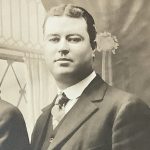Sepia Saturday 547. Seventeenth in a series about Albert Barney Charboneau — my paternal grandfather’s brother who died in the Great Influenza Pandemic of 1918.

When the 1918 influenza pandemic swept through Dolgeville, N.Y. — where my dad’s ancestors lived — only his Uncle Albert, 33, caught the dreaded virus and died.
“Nobody else in the family caught it, only Albert,” he told me — and I had to wonder why.
Of the four Charboneau brothers, Albert was the oldest and seemingly the most robust — with enough energy to hold a full-time job as foreman of woodwork in Julius Breckwoldt’s piano-related lumber works and be active in fraternal groups besides.
He was described as tall and stout when he registered for the WWI draft — and photos of Albert with his wife’s family, the Millers, bear out his stature.

A medical mystery
As we have learned from the current COVID-19 pandemic, viruses behave in specific ways that provoke an immune response — sometimes so strong it overwhelms their human host.
Scientists have speculated that this may be why the 1918 influenza took a heavy toll among the young and robust — such as the WWI troops — many of whom did not survive their body’s strong immune response.
Perhaps that was the case with Albert. His Utica Herald-Dispatch obituary, on 24 Oct. 1918, said he died from pneumonia after contracting influenza — possibly brought on by a powerful immune response in the lungs.

An obituary clue
As with today’s coronavirus, those with pre-existing medical conditions also likely fared worse during the 1918 influenza pandemic. And according to Albert’s obituary in the Little Falls and Courier (29 Oct. 1918), he had a co-morbidity that made him vulnerable.
Albert B. Charbonneau passed away Wednesday afternoon at his home on State street, after making a valiant fight against Bright’s disease superceded [sic] by influenza.
Bright’s disease was a term used at that time to describe chronic inflammatory disease of the kidneys (today called nephritis) — often accompanied by high blood pressure, heart disease and excess weight.
Events and gatherings
Finally there was Albert’s role at work and in his fraternal groups — all of which required his presence at large gatherings where he could have caught the flu before social distancing was widely encouraged.

The influenza was prevalent in the U.S. Navy during the fall of 1918, and Naval officers visited Julius Breckwoldt’s lumber company, where Albert worked, to select wood for seaplanes. Could they have exposed him to influenza?
As foreman of woodwork, Albert may also have visited Breckwoldt’s crowded lumber camps — with or without Naval officers — to see about wood supplies for the piano factory. Could he have caught it there?
Finally, as the head of the Dolgeville Mason’s lodge, Albert would have been in demand for ceremonies, member funerals and other gatherings — any of which could have been influenza-spreading events in the fall of 1918.
Many of these questions will remain unanswered. Yet however he caught the influenza, and whatever his risk factors, Uncle Albert’s death from the 1918 influenza left a hole in the Charboneau family of Dolgeville, N.Y. — and they never forgot him.
Next in this series: Bidding farewell to Uncle Albert. Meanwhile, please visit the blogs of this week’s other Sepia Saturday participants here.
© 2020 Molly Charboneau. All rights reserved.
